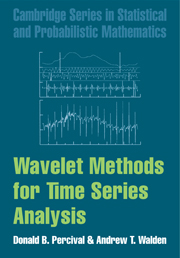Book contents
- Frontmatter
- Contents
- Preface
- Conventions and Notation
- 1 Introduction to Wavelets
- 2 Review of Fourier Theory and Filters
- 3 Orthonormal Transforms of Time Series
- 4 The Discrete Wavelet Transform
- 5 The Maximal Overlap Discrete WaveletTransform
- 6 The Discrete Wavelet Packet Transform
- 7 Random Variables and StochasticProcesses
- 8 The Wavelet Variance
- 9 Analysis and Synthesis of Long MemoryProcesses
- 10 Wavelet-Based Signal Estimation
- 11 Wavelet Analysis of Finite EnergySignals
- Appendix. Answers to Embedded Exercises
- References
- Author Index
- Subject Index
6 - The Discrete Wavelet Packet Transform
Published online by Cambridge University Press: 05 December 2013
- Frontmatter
- Contents
- Preface
- Conventions and Notation
- 1 Introduction to Wavelets
- 2 Review of Fourier Theory and Filters
- 3 Orthonormal Transforms of Time Series
- 4 The Discrete Wavelet Transform
- 5 The Maximal Overlap Discrete WaveletTransform
- 6 The Discrete Wavelet Packet Transform
- 7 Random Variables and StochasticProcesses
- 8 The Wavelet Variance
- 9 Analysis and Synthesis of Long MemoryProcesses
- 10 Wavelet-Based Signal Estimation
- 11 Wavelet Analysis of Finite EnergySignals
- Appendix. Answers to Embedded Exercises
- References
- Author Index
- Subject Index
Summary
Introduction
In Chapter 4 we discussed the discrete wavelet transform (DWT), which essentially decomposes a time series X into coefficients that can be associated with different scales and times. We can thus regard the DWT of X as a ‘time/scale’ decomposition. The wavelet coefficients for a given scale Tj ≡ 2J−1 tell us how localized weighted averages of X vary from one averaging period to the next. The scale Tj gives us the effective width in time (i.e., degree of localization) of the weighted averages. Because the DWT can be formulated in terms of filters, we can relate the notion of scale to certain bands of frequencies. The equivalent filter that yields the wavelet coefficients for scale Tj is approximately a band-pass filter with a pass-band given by [l/2j+1, 1/2j]. For a sample size N = 2J, the N - 1 wavelet coefficients constitute - when taken together - an octave band decomposition of the frequency interval [1/2J+1, 1/2], while the single scaling coefficient is associated with the interval [0, 1/2J+1]. Taken as a whole, the DWT coefficients thus decompose the frequency interval [0, 1/2] into adjacent individual intervals.
In this chapter we consider the discrete wavelet packet transform (DWPT), which can be regarded as any one of a collection of orthonormal transforms, each of which can be readily computed using a very simple modification of the pyramid algorithm for the DWT.
- Type
- Chapter
- Information
- Wavelet Methods for Time Series Analysis , pp. 206 - 254Publisher: Cambridge University PressPrint publication year: 2000
- 5
- Cited by

